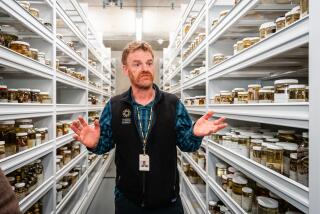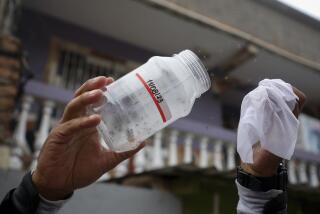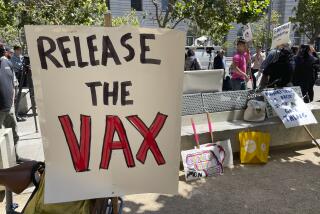Science / Medicine : Hope on Malaria : Colombian Claiming Victory in Race to Develop Vaccine Against Killer
- Share via
BOGOTA, Colombia — There has never been an effective vaccine for malaria, scourge of the tropics and killer of millions.
Now, many experts--although cautious--agree that rapidly advancing knowledge about immunology and malaria has reached the threshold of producing a vaccine that can prevent one of the most widespread and troublesome diseases ever known.
And in the race to discover a preventive agent, one researcher, Dr. Manuel E. Patarroyo, is claiming victory.
Patarroyo has tested his vaccine on hundreds of soldiers stationed in Colombia’s Amazon lowlands, where malaria is endemic. Until a report on the field testing is published--he has submitted it the journal Nature--he does not want to divulge details, but he smiles triumphantly when asked about the result.
“It couldn’t be better,” said Patarroyo, 42. “It is extremely positive.”
More than 100 million people a year are believed to suffer from malaria, and the annual death toll worldwide is estimated in the millions, with most of the fatalities in Africa. Although malaria can be cured with modern medicines, most victims lack access to effective treatment.
The need for a vaccine has become more urgent in recent years because some varieties of the disease, as well as some mosquitoes that carry it, have become resistant to widely used medicines and pesticides.
In the United States, South America, Europe and other parts of the world, researchers are applying bioengineering techniques in concerted efforts to develop malaria vaccines. Among promising projects are those at New York University, Walter Reed Army Medical Center, the University of Maryland and the Pasteur Institute in Paris.
Some research aims at protection from the malaria sporozoite transmitted by mosquitoes. Other projects target the parasite at the merozoite stage in which it attacks red blood cells. It is believed that any vaccine will have to be protective against these different stages in the life cycle of the parasite that causes malaria.
According to Patarroyo and other experts, his work is among the most advanced blood-stage research being done anywhere. No one else has successfully tested a blood-stage vaccine on human subjects, according to Dr. Lindsay Martinez, a World Health Organization specialist in Geneva.
“He seems to have shown substantial levels of protection, and that is encouraging,” Martinez said of Patarroyo’s research.
A thin man with a narrow face and a receding hairline, Patarroyo was wearing a baggy sweater one recent Saturday morning as he showed a visitor through his laboratories.
He explained the process of isolating merozoites, analyzing their atomic
structure and duplicating key parts of the structure by chemical synthesis. Stepping into the chemical synthesis room, he scooped up half a dozen vials full of white powder that might be mistaken for baking soda.
“This is it,” he said, opening a vial and shaking white powder into the visitor’s hand. “This is the vaccine.”
A vaccine is desperately needed in Colombia and some nearby countries where malaria has been spreading rapidly. The Pan American Health Organization said it received reports of 1.1 million cases in the Western Hemisphere in 1988, up from 931,000 in 1984.
In Colombia, the number of reported cases jumped to 101,000 from 55,000 in the same period, while Mexico reported an increase to 116,000 from 85,000. In Brazil, Latin America’s most populous country, the increase was to 565,000 from 378,000 cases.
“We can consider it an epidemic,” said Joselio Branco, head of the Brazilian Health Ministry’s anti-disease campaign office.
Branco said the Brazilian death toll from malaria is not known, but he estimated that between 1% and 3% of all cases are fatal. At that rate, up to 17,000 Brazilians died of malaria in 1988.
The World Bank is preparing to lend Brazil $99 million for an anti-malaria program that will include spraying for mosquitoes and treating patients. The Brazilian government will match the World Bank funds.
About 95% of Brazil’s cases are in the Amazon region, and nearly half are in Rondonia, a state the size of Oregon that is being invaded by settlers and gold prospectors.
Orestes Muniz, vice governor of Rondonia, said the state’s hospitals overflow with malaria patients. “Sometimes there are two or three persons per bed,” Muniz said.
Although Muniz had not heard of Patarroyo’s research in Colombia, he said a malaria vaccine would be a godsend for Rondonia.
“It would mean a liberation from the nightmare” of malaria, he said.
The histories of Latin America, Africa and Asia are replete with malaria nightmares that have frustrated ambitious development projects and decimated work forces.
When the French tried and failed to build a canal through Panama in the late 1800s, malaria and other diseases killed at least 20,000 workers over a decade. The United States completed the canal only after controlling malaria and yellow fever.
Malaria is believed to have been brought to the New World after the voyage of Columbus. In tropical South America, malaria is one of several imported diseases that helped reduce Indian populations to a fraction of their former size.
Early in the 19th Century, Europeans found that quinine, distilled from the bark of the South American cinchona tree, was useful in treating the disease. In the 1880s and ‘90s, they discovered that malaria was caused by the one-celled Plasmodium parasite, which is transmitted by anopheles mosquitoes.
DDT has been used to control the mosquitoes in some countries, but they are becoming resistant to insecticide in many areas. And increasingly widespread strains of the most lethal malaria parasite, Plasmodium falciparum, have become resistant to chloroquine, the most effective drug for treating the disease.
It is the P. falciparum parasite that Patarroyo’s vaccine is designed to combat.
In Colombia, where P. falciparum infests the southern Amazon area, malaria was the registered cause of about 2,000 deaths last year, Patarroyo said. But he estimated that the real number of malaria deaths could be three to four times that number.
Patarroyo studied immunology at Rochester University under Dr. Gerald Edelman, winner of the 1972 Nobel Prize for medicine, and later founded the Institute of Immunology at the San Juan de Dios Hospital in Bogota. He now directs a 40-member research staff at the institute.
The synthetic protein combinations, or peptides, made in the labs are identical to the harmless parts of the falciparum parasite that attach to red cells in the blood, Patarroyo said. He said the peptides stimulate the release of antibodies into the blood, providing protection should the real parasite strike.
He predicted that the same principles of chemical synthesis will soon produce not only vaccines for other varieties of malaria but also for such diseases as tuberculosis and leprosy.
Patarroyo tested the vaccine on monkeys in 1986, announcing the results in 1987. He then tested it on groups of army volunteers--first only a few, then 25, 70, 150.
The vaccine was “challenged” by injections of live malaria parasites. Patarroyo reported that the protection was generally successful.
The vaccine has been field tested for the last nine months on soldiers stationed in rural areas of southern Colombia. Patarroyo indicated that none of the hundreds of soldiers who received two doses of the vaccine have come down with malaria, while many unvaccinated soldiers in the same areas have.
He said he will report on field testing of the vaccine in articles to be published this summer. Preparations are being made for more field testing in Venezuela and Brazil.
The World Health Organization asked the U.S. government’s Centers for Disease Control in Atlanta to verify the results of Patarroyo’s trials with monkeys. Dr. Trenton Ruebush, a researcher with the CDC’s Malaria Branch, said trials with monkeys in Atlanta were unsuccessful, so he and another CDC researcher repeated the testing in Patarroyo’s laboratories.
“What we are finding now is that in the trials being done down here, the monkeys do show protective responses to all three peptides,” Ruebush said in Bogota. “We are satisfied that the antibody levels reported in the literature are correct.” Patarroyo said the Atlanta failure was the result of flaws in the preparation of the vaccine by a private U.S. firm.
Ruebush commended Patarroyo’s research. “Dr. Patarroyo’s group here has made some impressive steps toward the development of an effective malaria vaccine,” the American said.
“But,” he cautioned, “I think it is fair to say that we still are a long way from a vaccine that would be used extensively in the field. Even after testing it in other countries, a lot of hard work has to be done in evaluation before it is distributed to ministries of health.”






